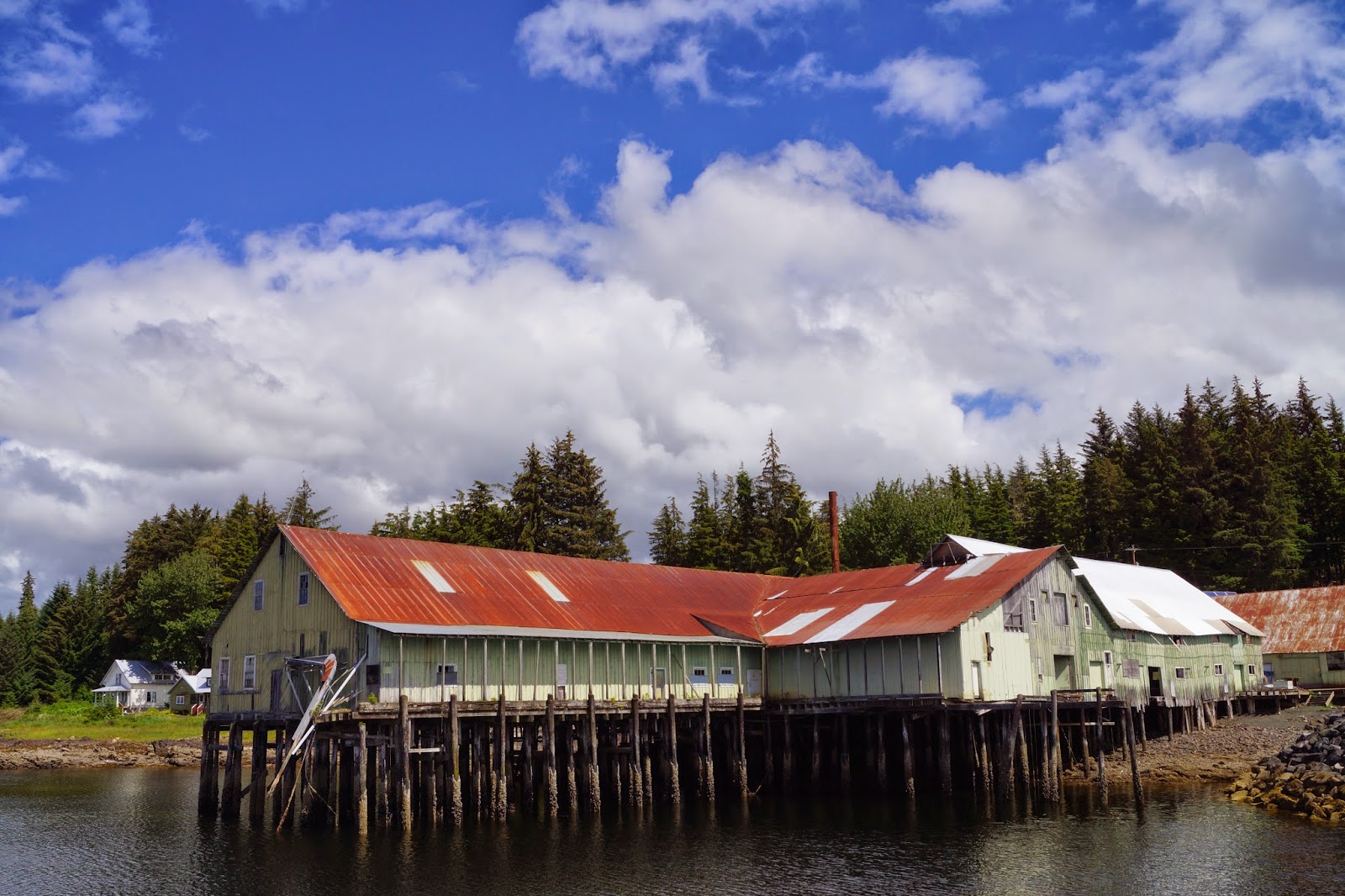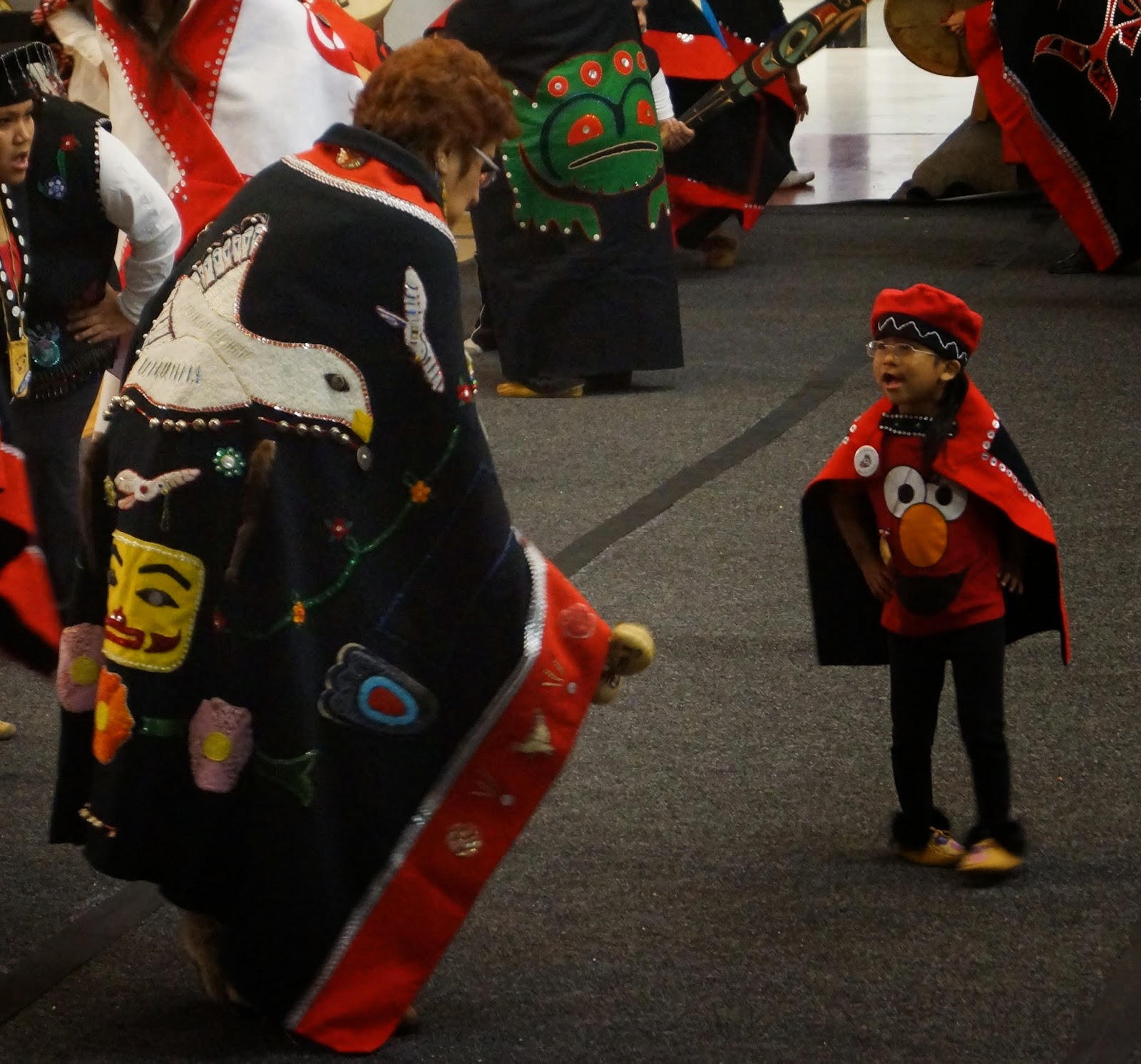One of our most excellent guides from Alaskan Dream Cruises, Leonty Williams, had been preparing us for our visit to Kake for days, by teaching us about the Tlingit, their history, culture, and efforts to preserve their heritage and community. Kake is almost exclusively inhabited by Tlingit people who still maintain much of what is called a "subsistence" lifestyle, meaning they still hunt, fish, and gather select botanicals for food and other uses. One of our guides in Kake however pointed out that their lives are so much richer than "subsistence."
Kake is primarily a fishing village, but the fishing house at the harbor doesn't seem to be in use. I'm not sure they have their own fish processing plant, or if it is just done non commercially.
After meeting our local guide and our bus driver (a local elder), our first stop was Michael Jackson's wood carving and jewelry studio. That's his real name, but not his Tlingit name. Most of the native people we met have both a tribal name and a Western (not sure that's the correct terminology) name. Mr. Jackson has been the master woodcarver and totem pole builder in the area for a long time. He demonstrated the various traditional tools and methods he uses.
Our next stop was Kake's claim to fame: the tallest single tree totem pole in the world. Here our guide explained some of its history and the legends its figures represent. (She is also a Tlingit language teacher in the community school.) The figure in the base position on the pole is called Strong Man. His legend tells of a competition of strength to become leader of the community. Long story short: he won by tearing a seal in half, which is what is depicted in this carving.
Totem poles are a real photographic challenge. Rick is trying to get it all in.
We loaded up our school bus again and drove to Gunnuk Creek, or "eagle highway" as we called it because of the number of bald eagles flying up and down the creek and perching all around it. The salmon were running so the eagles were watching and fishing I assume, though we didn't see them actually fish.
Here's an immature bald eagle that sat still for me. There must have been at least 50 hanging around and flying back and forth from their roosts overlooking the creek to the harbor.
We saw our first salmon here too.
Our final stop in Kake was the high school gymnasium where a group of local Tlingit performed traditional dances and songs for us. The banner below has the Tlingit name of the town, Keex'Kwaan, printed on it, as well as the eagle (left) and raven (right), the two moieties into which all Tlingit people are divided. (Not to be confused with athletic mascots that you might see on banners in high school gyms.) Within the moieties there are also clans identified with animals, such as bear, frog and orca. The dance regalia has clan symbols sewn or beaded on the back. These can be seen in some of the pictures below.
The town's people gathered for the performance and for a small market to sell handcrafted wares such as wood carvings, jewelry, devil's club salve and wild berry jams. We saw many children being guided by their friends and family as to how to participate, in a very relaxed, natural manner. Below, one of the elders is playing the drum softly for the littlest dancer as others watch and encourage her.
Here another elder encourages a young dancer. Love the T-shirt. Is that the Elmo clan?
The spokesperson that day was an elder woman who we learned is the primary teacher of dance and song in the community. She was lovely and gracious in her welcome. The dancers traditionally stand with their backs to the audience to show their clan symbols, so we "know who they are."
The dancers/singers were men, women, boys and girls of all ages, with wonderfully strong voices, presence and grace. The roles were pretty gender specific, with the women singing and playing drums in more supportive roles, and the men doing much of the more fancy dancing. Here the men are doing a dance in which the women are rounding them up in a contained space. It was all very interesting. The tall man in the bear fur hat is our Alaskan Dream expedition leader Leonty, who is something of a leader in the Southeast Alaska community, at least in terms of dancing.
The experience ended with an invitation extended to join the dance, and most of us did. The men from the cruise were especially enthusiastic dancers. I think Leonty was a real inspiration and role model for them. It looked like the Tlingit women were going to have to round them up to settle them down. Perhaps that's what they wanted.
 |
| The island burial ground for Kake |
A sense of peace and generosity pervaded our visit to Kake. It concluded with the option of a walk through the town and back to the boat. We could see what Leonty had prepared us for - that the town is not "pretty" in the same sense that a town like Petersburg is. We are not accustomed to associating homes and yards that seem to be uncared for with a strong sense of family and community. But we saw firsthand that the beauty here is in the people and their relationship to nature; their pride is in their songs, dances, stories and language, if not in their houses, property and landscaping.













No comments:
Post a Comment
Want to leave a comment?